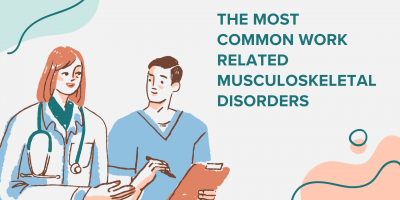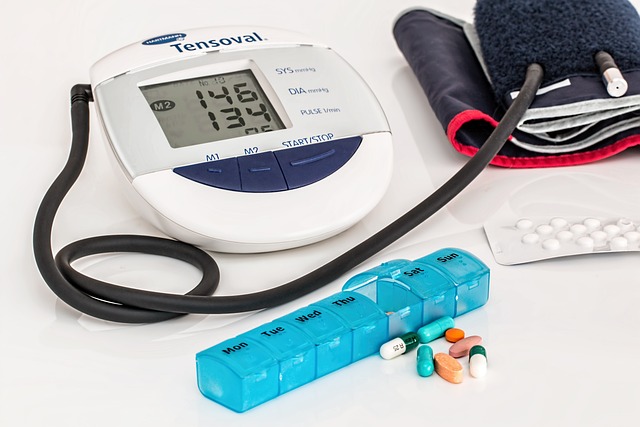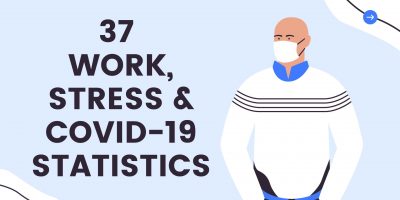
The Most Common Work-Related Musculoskeletal Disorders
Affecting billions, work-related musculoskeletal disorders are a major health concern. Understanding how and why they happen is the first line of defense in the workplace.

Heart disease is affecting millions of people globally, and the workplace is no exception. As we enter American Heart Month and National Wear Red Day, it’s crucial to take a closer look at the state of heart disease in the workplace.
With more than 80% of jobs in the US mostly involving sedentary activities, workers are exposed to long sitting hours and a lifetime of physically inactive behaviors. Additionally, many workplaces offer unhealthy food and drink options, making it easy for employees to fall into unhealthy habits.
The global economic slowdown and record-high inflation of the past year have also added stress to the mix, making it even more crucial for employers to take action in promoting cardiovascular health (CVH) among their workforce.
Employers have the opportunity to make a lasting impact on the well-being of their employees by implementing heart-healthy initiatives and mitigating the risk of heart disease.

Cardiovascular disease is the leading cause of death for both men and women in the United States. According to the American Heart Association, it accounted for over 860,000 deaths in 2017 alone. In the United States, almost half of all adults have at least one form of heart disease.
Cardiovascular diseases (CVDs) are conditions affecting the heart or blood vessels . CVDs are commonly linked with a build-up of fatty deposits within the arteries, known as atherosclerosis, and an increased risk of blood clots (thrombosis).
According to the AHA, are six main types of cardiovascular diseases (CVDs):
While CVD is one of the leading causes of death and disability in the US, it can often be prevented or improved by leading a healthy lifestyle.
Cardiovascular disease is a global epidemic, responsible for 32% of all deaths worldwide. As such, CVDs pose possibly the biggest threat to the health and well-being of employees.
It is widely recognized that certain occupational factors can contribute to, or even cause, cardiovascular disease (CVD). These exposures can range from common occurrences in the workplace to rare instances.
Physical Impacts & Heart Disease
Chemical Hazards & Heart Disease
Psychosocial Factors & Heart Disease
Cardiovascular diseases – often referred to as the “silent killers” – can be particularly deadly because they often have no visible symptoms. In fact, many people are not even aware that they have a problem with their blood vessels until it’s too late.
Furthermore, the symptoms of a heart attack, heart failure, or arrhythmia can vary greatly, making it even more difficult to identify early signs.
Symptoms
For example, a heart attack can present symptoms such as chest pain or discomfort, upper back or neck pain, extreme fatigue, upper body discomfort, dizziness, and shortness of breath.
On the other hand, an arrhythmia may cause fluttering feelings in the chest, also known as palpitations. And with heart failure, a person may experience shortness of breath, fatigue, or swelling of the feet, ankles, legs, abdomen, or neck veins.
Unfortunately, early research on heart attacks primarily focused on male subjects, leading to a narrow understanding of the symptoms of heart attacks in women – which are often thought to be chest pain and discomfort in the left arm.
However, women may experience “atypical” symptoms, such as nausea and general discomfort. As a result, studies have shown that women are 50% more likely to be misdiagnosed following a heart attack and are also more likely to die from a heart attack than men.

Screening & Diagnoses
Understanding how CVDs affect men and women is crucial in preventing delayed diagnosis and treatment. Several screens and tests, which can be done at an annual physical, can determine if an individual has a CVD or is at risk of developing one, such as:
Cardiologists can do the following tests to determine and diagnose the heart condition:
By understanding the various screens and tests available, individuals can take an active role in their health and detect CVDs early on.
Despite the prevalence of heart diseases, it is often seen as shocking when it affects individuals who appear to be in good health. One reason for this may be due to the tendency to overlook the impact of stress, a significant risk factor that is often underestimated.
Long working hours, pressing deadlines, and the expectation to maintain a high level of performance can lead to excessive stress levels for employees. The detrimental effects of work-related stress, such as insomnia, burnout, and decreased productivity, are well-known.
Furthermore, it can also exacerbate mental health conditions like anxiety and depression.
However, the question remains, can the stress caused by work be so severe that it causes a heart attack?
According to recent research, work-related stressors, such as high job demands and prolonged working hours, have moderately increased the risk of developing coronary heart disease and stroke.
The excess risk for individuals exposed to these stressors is estimated to be between 10-40% compared to those without such stressors. Importantly, this association is found to apply to both men and women, as well as employees of different ages and socioeconomic backgrounds.
Many might not realize it, but workplace culture can also have a substantial effect on heart health. Workplace conditions, such as job pressures, discrimination, microaggressions, and sedentary activity, can significantly impact employees’ cardiovascular and emotional responses throughout the day.
Chronic exposure to these forms of workplace stress can trigger the “fight or flight response,” releasing cortisol and triggering an inflammatory response that accelerates the thickening or hardening of the arteries. This is known as the “atherosclerotic process” and is a major contributor to heart attacks.
Undoubtedly, heart disease and work stress are closely linked, with many studies showing that chronic stress can increase the development of cardiovascular disease risks. Not only is this a concern for employees, but also for employers who are facing rising healthcare costs and lost productivity due to this debilitating condition.
Improving productivity and employee health go hand in hand. When employees are healthy, they tend to be more productive, have lower healthcare costs, fewer health-related limitations on their work, higher retention, and fewer absences.
As the leading cause of death in the United States, heart disease and strokes ake a toll on individuals their loved ones, and the workplace. The human and financial costs of these conditions can be staggering, leaving employers with a responsibility to address this pressing issue.
Human Costs: Employees with Heart Conditions
One of the most critical issues facing employees with CVDs is heart failure and returning to work. Heart disease and strokes take a toll on employees’ physical and emotional well-being and significantly impact their ability to work.
Work’s physical and mental demands can be challenging for someone recovering from a heart attack or dealing with heart failure, and many employees may not be able to return to work at all. This can lead to prolonged absence from work, increased medical expenses, and a lower quality of life for the affected employee.
Employees with heart conditions often have to take time off for medical appointments and treatments and may even have to take extended leave if their condition worsens. This affects the employee’s productivity and puts a strain on their colleagues, caregivers, and the business as a whole.
Business Costs: Employer Responsibility for Employees with Heart Diseases
The direct medical costs of CVD are expected to triple to over $800 billion by 2030, and employers bear a significant portion of these costs through employee health insurance and disability payments. However, for employersheart disease and stroke costs are not limited to healthcare expenses.
The financial burden also includes indirect costs from lost productivity, absenteeism, and short-term disability. In the first month alone, employers may see a cost increase of over $1,119 due to employee absenteeism and short-term disability.
Although the first month following a cardiovascular event has the highest cost, it can continue for up to three years, as employees may require additional time off for recovery and rehabilitation.
Employers can take certain steps to reduce the cost of heart disease in the workplace. Encouraging healthy lifestyle choices and providing access to preventative care can help prevent the onset of heart conditions and reduce the financial burden on the business.
Coronary heart disease is a complex condition influenced by a combination of factors, some of which individuals have no control over. For example, family history, ethnic background, and even complications during pregnancy can all play a role in cardiovascular disease development.
One of the most significant risk factors for heart disease is high blood pressure, which can be caused or exacerbated by lifestyle factors such as:
In fact, cardiovascular health research has shown that nearly half of all people in the United States (47%) have at least one of these three risk factors. What’s more, these risk factors are cumulative, meaning that the more of them you have, the greater your risk becomes.
The good news is that individuals can take steps to reduce their risk of heart disease, even if they can’t control certain factors. By avoiding tobacco use, maintaining a healthy weight, being physically active, and following a nutritious diet, individuals can reduce their risk of coronary artery disease and sudden cardiac death by an impressive 80%.
One of the most alarming scenarios for employees with heart conditions is the possibility of a heart attack at work. This not only puts the employee’s health at risk but also raises important questions about employer responsibility for employee heart attacks.
Employers must provide a safe working environment for all employees, including taking appropriate measures to prevent heart disease in the workplace. Some of these measures include providing access to regular health screenings, promoting healthy lifestyles, and providing accommodations for employees with heart conditions.
Working with a heart condition can be a difficult challenge for both employees and employers. Congestive heart failure, in particular, can come with strict work restrictions limiting an individual’s ability to perform specific tasks or work in certain environments.
However, employers are required to abide by the Americans with Disabilities Act (ADA), which prohibits discrimination against employees with heart conditions that qualify as a disability under federal law.
Employers should also make reasonable accommodations to help employees manage their condition, such as flexible scheduling, providing parking close to the office, and time off for medical appointments.
To help mitigate these challenges of working with congestive heart failure, individuals with heart conditions can take steps to manage their condition and improve their chances of finding and keeping a job.
For example, they can work with their healthcare provider to develop a care plan that includes regular check-ups, a disease management program enrollment, and lifestyle changes such as diet and exercise.
They can also seek out resources such as the CDC stroke prevention program, which provides information and support for individuals at risk of stroke or heart attack.

With the majority of American adults spending more time at work than any other activity, companies must take steps to improve their employees’ overall health and well-being.
One effective way to promote heart wellness at work is through incentives. Giving employees economic incentives to lead a healthier lifestyle can be a powerful approach to increase adherence to lifestyle recommendations.
However, it’s essential to consider the potential downsides and tailor incentives to individual workers to maximize benefits. For example, workers with chronic illnesses or very high body indices may be unable to reach certain health goals, which would penalize them compared to their healthier peers.
Another important aspect of promoting heart wellness at work is recognizing that there isn’t a one-size-fits-all approach. The AHA recommends an incremental approach for companies starting wellness or workplace health programs. Such efforts should be focused on the following:
Investing in the cardiovascular health of employees benefits not only the employees themselves but also the employer. Heart-healthy employees save employers money, have better morale, and are more productive than less healthy employees. It’s a win-win situation for both the employee and the employer.
In conclusion, heart disease in the workplace is a significant health concern that affects many individuals. It is imperative that companies prioritize heart health and create a culture of well-being not just during American Heart Month, but every day. Maintaining a heart-healthy workforce requires consistent and daily effort.
Disclosure: Some of the products featured in this blog post may come from our partners who compensate us. This might influence the selection of products we feature and their placement and presentation on the page. However, it does not impact our evaluations; our opinions are our own. The information provided in this post is for general informational purposes only.
Browse our curated list of vendors to find the best solution for your needs.
Subscribe to our newsletter for the latest trends, expert tips, and workplace insights!

Affecting billions, work-related musculoskeletal disorders are a major health concern. Understanding how and why they happen is the first line of defense in the workplace.
To what extent do breast cancer patients struggle with financial toxicity while battling this illness? What factors contribute to this financial toxicity?

Gain insight into the current state of adoptions in the United States with 50+ crucial statistics and trends, providing valuable information on the evolving adoption landscape.

Explore 30+ statistics on work, stress, and the impact of COVID-19, providing valuable insights into the challenges employees face in today’s dynamic work environment.
Used by most of the top employee benefits consultants in the US, Shortlister is where you can find, research and select HR and benefits vendors for your clients.
Shortlister helps you reach your ideal prospects. Claim your free account to control your message and receive employer, consultant and health plan leads.